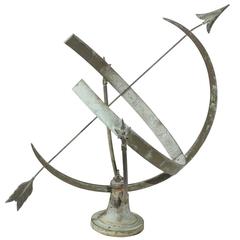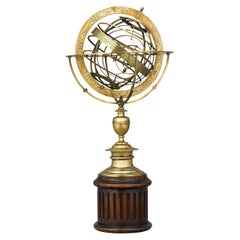Antique Armillary Sphere Sundial
Recent Sales
Early 20th Century European Antique Armillary Sphere Sundial
Metal
17th Century Antique Armillary Sphere Sundial
Brass, Bronze
1890s English Renaissance Revival Antique Armillary Sphere Sundial
Metal
Early 1900s French Antique Armillary Sphere Sundial
Copper, Iron
Late 19th Century English Late Victorian Antique Armillary Sphere Sundial
Carrara Marble, Steel
17th Century Antique Armillary Sphere Sundial
Brass, Bronze
Early 20th Century American Antique Armillary Sphere Sundial
Iron, Wrought Iron
19th Century Antique Armillary Sphere Sundial
Stone, Metal
Early 20th Century Swedish Antique Armillary Sphere Sundial
Antique Armillary Sphere Sundial For Sale on 1stDibs
How Much is a Antique Armillary Sphere Sundial?
Finding the Right Sundials for You
Although typically decorative, antique and vintage sundials transport a guest in your home to a different era, their simple function a tether to the ancient world.
Humans have tracked time since the dawn of civilization. Before the invention of precise mechanical clocks, various materials including water and incense were used to mark the passage of time. The sundial was one of the earliest of these timekeeping devices.
The oldest known sundial dates back to 1,500 B.C. in Egypt. The very first sundials were simple stone blocks with markings and a vertical needle of wood or metal to indicate the hours with its shadow. Later Greek sundials had a gnomon parallel to the axis of the Earth. Some flat sundials from the Islamic world were directional objects for pointing the way to Mecca.
Mechanical clocks use a series of gears and springs to track time precisely; sundials rely on light and shadow. As sunlight crosses over a sundial, it casts a shadow that moves across the face of the dial as the Earth rotates.
There are now more accurate, easier and probably cooler ways to tell time, yet the sundial persists. It is not uncommon to find flat stone sundials among an assemblage of decorative elements in colorful gardens and standing sundials in expertly appointed outdoor spaces.
While garden sundials are among the most popular sundials today, sundials made of metal, stone, bronze and more can be found on 1stDibs to match any taste or setting. The collection also includes sundials of Scandinavian, British and North American origins.
Read More
39 Incredible Swimming Pools
It's hard to resist the allure of a beautiful pool. So, go ahead and daydream about whiling away your summer in paradise.
This Lavish 18th-Century Chimneypiece Comes from a Historic Scottish Estate
The exceptionally crafted mantel was saved despite the home’s regrettable demise.
A Pair of Monumental Stone Tigers Protect and Guide Wandering Souls
The Qing dynasty beasts honored the dead and warned off malicious spirits.
Andrés Monnier’s Stone Tub Makes Bathing a Rite of Renewal
The dramatic piece transforms a daily scrub into an act of communion with the elements.
Meet the Siblings behind the Exquisite Outdoor Furniture of McKinnon and Harris
Anne and Will Massie apply the lessons of the past to create alfresco pieces as timeless as the traditions that inspire them.
35 Wondrous Outdoor Dining Spaces
Eating meals alfresco is one of the great pleasures of warm weather, and a beautifully appointed space only heightens the experience. Get inspired by these delectable dining areas as you think about creating your own outdoor oasis.
In These Chic Homes, Indoors and Outdoors Freely Mingle
Through potted plants, garden furniture, nature-inspired art and architectural apertures, designers are bringing the outside in.
24 Perfect Patios with Fire Pits and Fireplaces
In these stylish spaces, the outdoor season extends year round.

